Accounting and Finance 2: Costing Methods and Decision Making Analysis
VerifiedAdded on 2021/11/05
|6
|1592
|21
Report
AI Summary
This report critically analyzes and compares traditional and Activity-Based Costing (ABC) methods, highlighting their respective strengths and weaknesses in the context of product costing and decision-making. The assignment begins by outlining the limitations of traditional costing, such as its reliance on average overhead rates and its inability to accurately reflect cost behavior in modern manufacturing environments. It then introduces ABC as a more reliable alternative, detailing its advantages, including accurate product costing, improved cost behavior information, and better decision-making capabilities. The report provides a practical example of a company transitioning from traditional costing to ABC, demonstrating the impact of each method on product profitability. Furthermore, the report discusses the limitations of ABC, such as its complexity and data requirements, and concludes with a justification for using ABC for decision-making purposes. The report also includes several references.
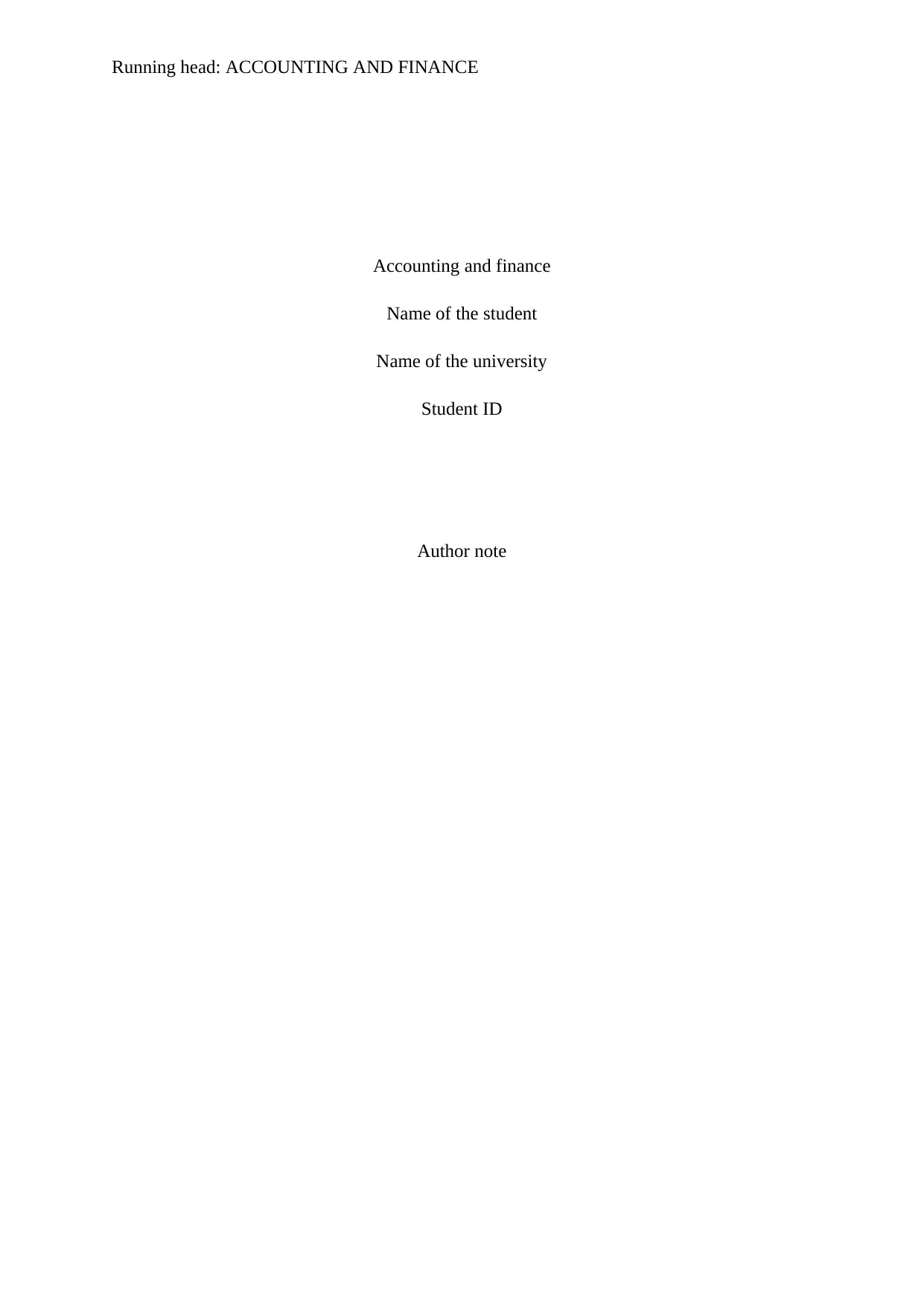
Running head: ACCOUNTING AND FINANCE
Accounting and finance
Name of the student
Name of the university
Student ID
Author note
Accounting and finance
Name of the student
Name of the university
Student ID
Author note
Paraphrase This Document
Need a fresh take? Get an instant paraphrase of this document with our AI Paraphraser
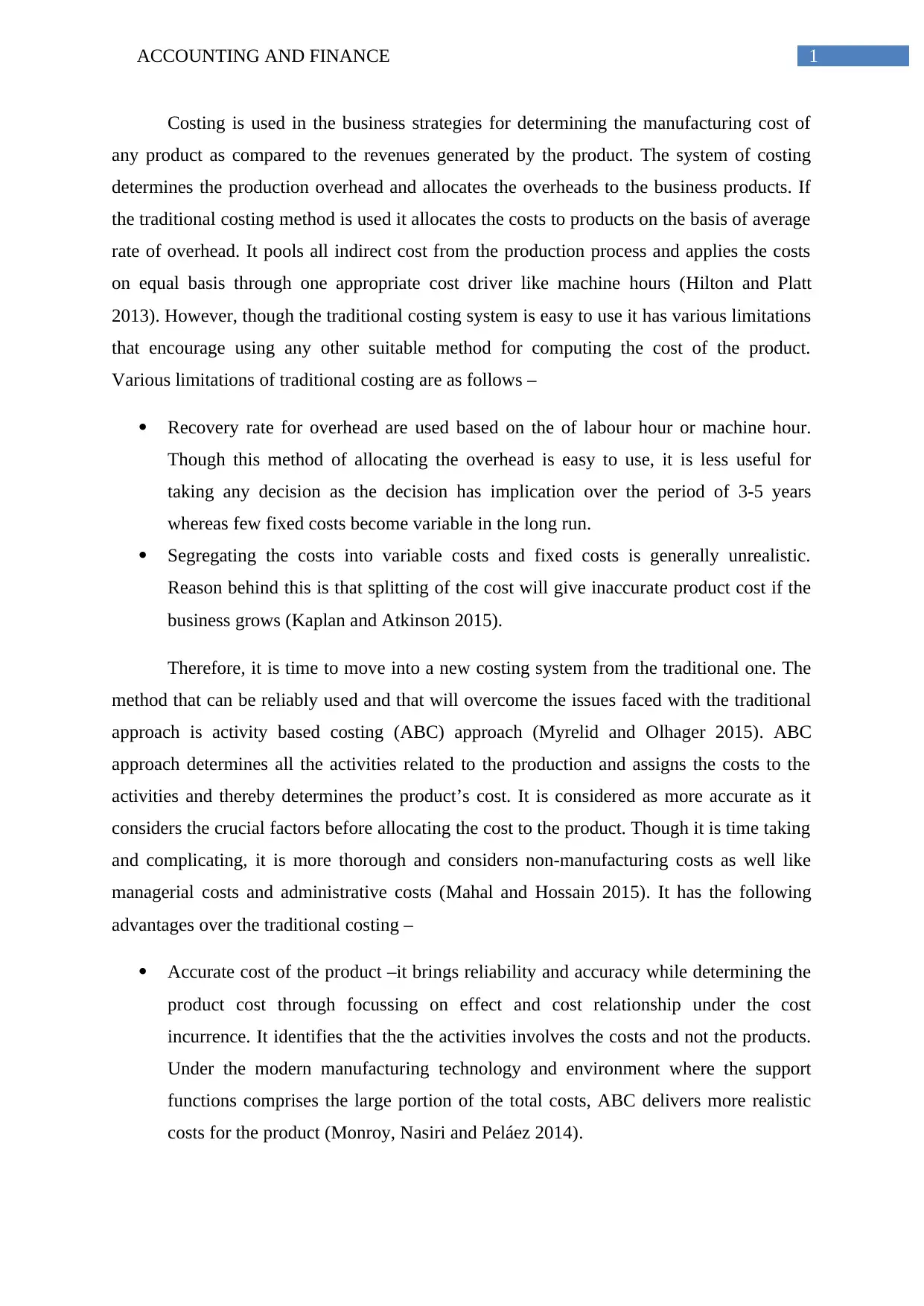
1ACCOUNTING AND FINANCE
Costing is used in the business strategies for determining the manufacturing cost of
any product as compared to the revenues generated by the product. The system of costing
determines the production overhead and allocates the overheads to the business products. If
the traditional costing method is used it allocates the costs to products on the basis of average
rate of overhead. It pools all indirect cost from the production process and applies the costs
on equal basis through one appropriate cost driver like machine hours (Hilton and Platt
2013). However, though the traditional costing system is easy to use it has various limitations
that encourage using any other suitable method for computing the cost of the product.
Various limitations of traditional costing are as follows –
Recovery rate for overhead are used based on the of labour hour or machine hour.
Though this method of allocating the overhead is easy to use, it is less useful for
taking any decision as the decision has implication over the period of 3-5 years
whereas few fixed costs become variable in the long run.
Segregating the costs into variable costs and fixed costs is generally unrealistic.
Reason behind this is that splitting of the cost will give inaccurate product cost if the
business grows (Kaplan and Atkinson 2015).
Therefore, it is time to move into a new costing system from the traditional one. The
method that can be reliably used and that will overcome the issues faced with the traditional
approach is activity based costing (ABC) approach (Myrelid and Olhager 2015). ABC
approach determines all the activities related to the production and assigns the costs to the
activities and thereby determines the product’s cost. It is considered as more accurate as it
considers the crucial factors before allocating the cost to the product. Though it is time taking
and complicating, it is more thorough and considers non-manufacturing costs as well like
managerial costs and administrative costs (Mahal and Hossain 2015). It has the following
advantages over the traditional costing –
Accurate cost of the product –it brings reliability and accuracy while determining the
product cost through focussing on effect and cost relationship under the cost
incurrence. It identifies that the the activities involves the costs and not the products.
Under the modern manufacturing technology and environment where the support
functions comprises the large portion of the total costs, ABC delivers more realistic
costs for the product (Monroy, Nasiri and Peláez 2014).
Costing is used in the business strategies for determining the manufacturing cost of
any product as compared to the revenues generated by the product. The system of costing
determines the production overhead and allocates the overheads to the business products. If
the traditional costing method is used it allocates the costs to products on the basis of average
rate of overhead. It pools all indirect cost from the production process and applies the costs
on equal basis through one appropriate cost driver like machine hours (Hilton and Platt
2013). However, though the traditional costing system is easy to use it has various limitations
that encourage using any other suitable method for computing the cost of the product.
Various limitations of traditional costing are as follows –
Recovery rate for overhead are used based on the of labour hour or machine hour.
Though this method of allocating the overhead is easy to use, it is less useful for
taking any decision as the decision has implication over the period of 3-5 years
whereas few fixed costs become variable in the long run.
Segregating the costs into variable costs and fixed costs is generally unrealistic.
Reason behind this is that splitting of the cost will give inaccurate product cost if the
business grows (Kaplan and Atkinson 2015).
Therefore, it is time to move into a new costing system from the traditional one. The
method that can be reliably used and that will overcome the issues faced with the traditional
approach is activity based costing (ABC) approach (Myrelid and Olhager 2015). ABC
approach determines all the activities related to the production and assigns the costs to the
activities and thereby determines the product’s cost. It is considered as more accurate as it
considers the crucial factors before allocating the cost to the product. Though it is time taking
and complicating, it is more thorough and considers non-manufacturing costs as well like
managerial costs and administrative costs (Mahal and Hossain 2015). It has the following
advantages over the traditional costing –
Accurate cost of the product –it brings reliability and accuracy while determining the
product cost through focussing on effect and cost relationship under the cost
incurrence. It identifies that the the activities involves the costs and not the products.
Under the modern manufacturing technology and environment where the support
functions comprises the large portion of the total costs, ABC delivers more realistic
costs for the product (Monroy, Nasiri and Peláez 2014).
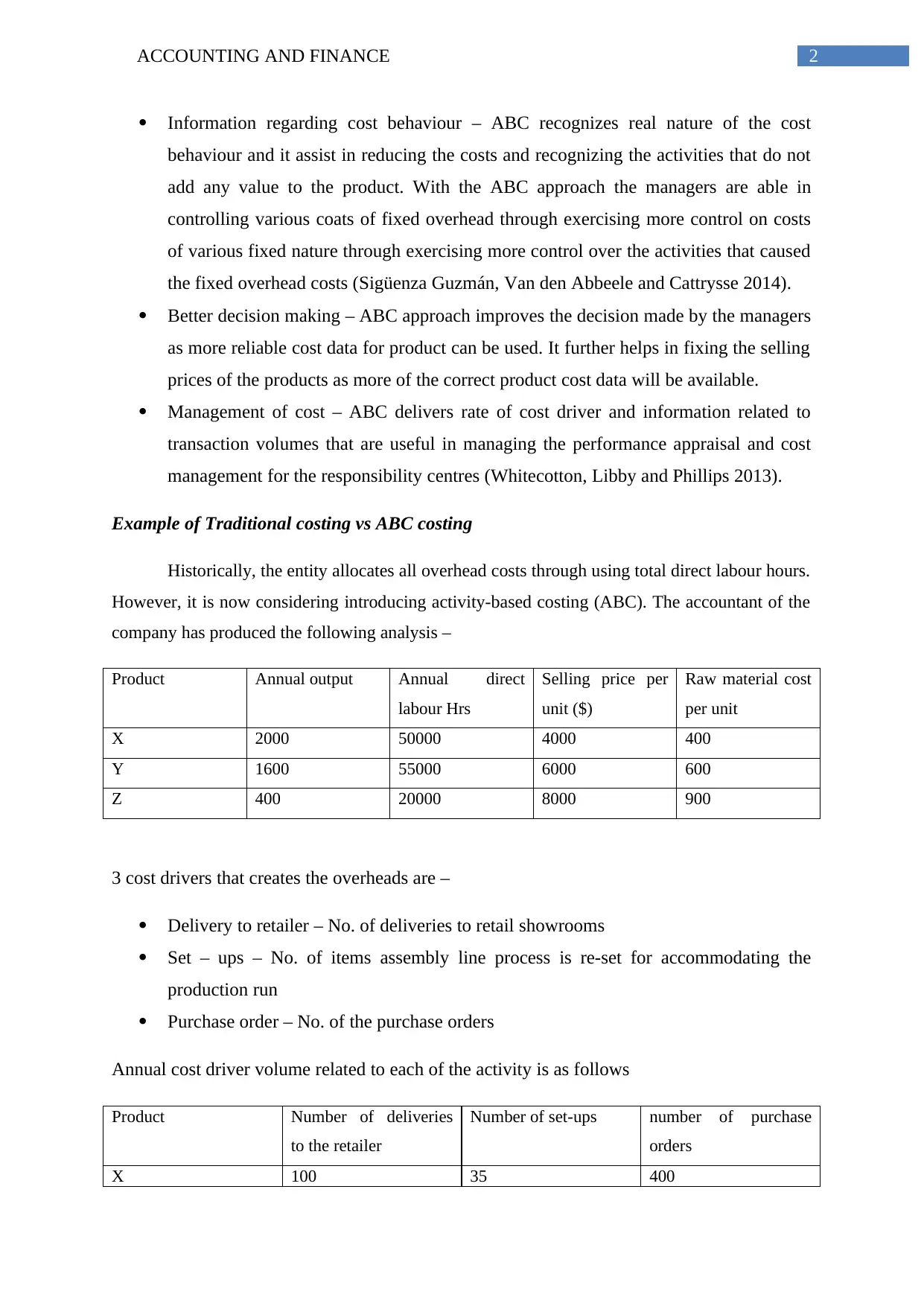
2ACCOUNTING AND FINANCE
Information regarding cost behaviour – ABC recognizes real nature of the cost
behaviour and it assist in reducing the costs and recognizing the activities that do not
add any value to the product. With the ABC approach the managers are able in
controlling various coats of fixed overhead through exercising more control on costs
of various fixed nature through exercising more control over the activities that caused
the fixed overhead costs (Sigüenza Guzmán, Van den Abbeele and Cattrysse 2014).
Better decision making – ABC approach improves the decision made by the managers
as more reliable cost data for product can be used. It further helps in fixing the selling
prices of the products as more of the correct product cost data will be available.
Management of cost – ABC delivers rate of cost driver and information related to
transaction volumes that are useful in managing the performance appraisal and cost
management for the responsibility centres (Whitecotton, Libby and Phillips 2013).
Example of Traditional costing vs ABC costing
Historically, the entity allocates all overhead costs through using total direct labour hours.
However, it is now considering introducing activity-based costing (ABC). The accountant of the
company has produced the following analysis –
Product Annual output Annual direct
labour Hrs
Selling price per
unit ($)
Raw material cost
per unit
X 2000 50000 4000 400
Y 1600 55000 6000 600
Z 400 20000 8000 900
3 cost drivers that creates the overheads are –
Delivery to retailer – No. of deliveries to retail showrooms
Set – ups – No. of items assembly line process is re-set for accommodating the
production run
Purchase order – No. of the purchase orders
Annual cost driver volume related to each of the activity is as follows
Product Number of deliveries
to the retailer
Number of set-ups number of purchase
orders
X 100 35 400
Information regarding cost behaviour – ABC recognizes real nature of the cost
behaviour and it assist in reducing the costs and recognizing the activities that do not
add any value to the product. With the ABC approach the managers are able in
controlling various coats of fixed overhead through exercising more control on costs
of various fixed nature through exercising more control over the activities that caused
the fixed overhead costs (Sigüenza Guzmán, Van den Abbeele and Cattrysse 2014).
Better decision making – ABC approach improves the decision made by the managers
as more reliable cost data for product can be used. It further helps in fixing the selling
prices of the products as more of the correct product cost data will be available.
Management of cost – ABC delivers rate of cost driver and information related to
transaction volumes that are useful in managing the performance appraisal and cost
management for the responsibility centres (Whitecotton, Libby and Phillips 2013).
Example of Traditional costing vs ABC costing
Historically, the entity allocates all overhead costs through using total direct labour hours.
However, it is now considering introducing activity-based costing (ABC). The accountant of the
company has produced the following analysis –
Product Annual output Annual direct
labour Hrs
Selling price per
unit ($)
Raw material cost
per unit
X 2000 50000 4000 400
Y 1600 55000 6000 600
Z 400 20000 8000 900
3 cost drivers that creates the overheads are –
Delivery to retailer – No. of deliveries to retail showrooms
Set – ups – No. of items assembly line process is re-set for accommodating the
production run
Purchase order – No. of the purchase orders
Annual cost driver volume related to each of the activity is as follows
Product Number of deliveries
to the retailer
Number of set-ups number of purchase
orders
X 100 35 400
⊘ This is a preview!⊘
Do you want full access?
Subscribe today to unlock all pages.

Trusted by 1+ million students worldwide
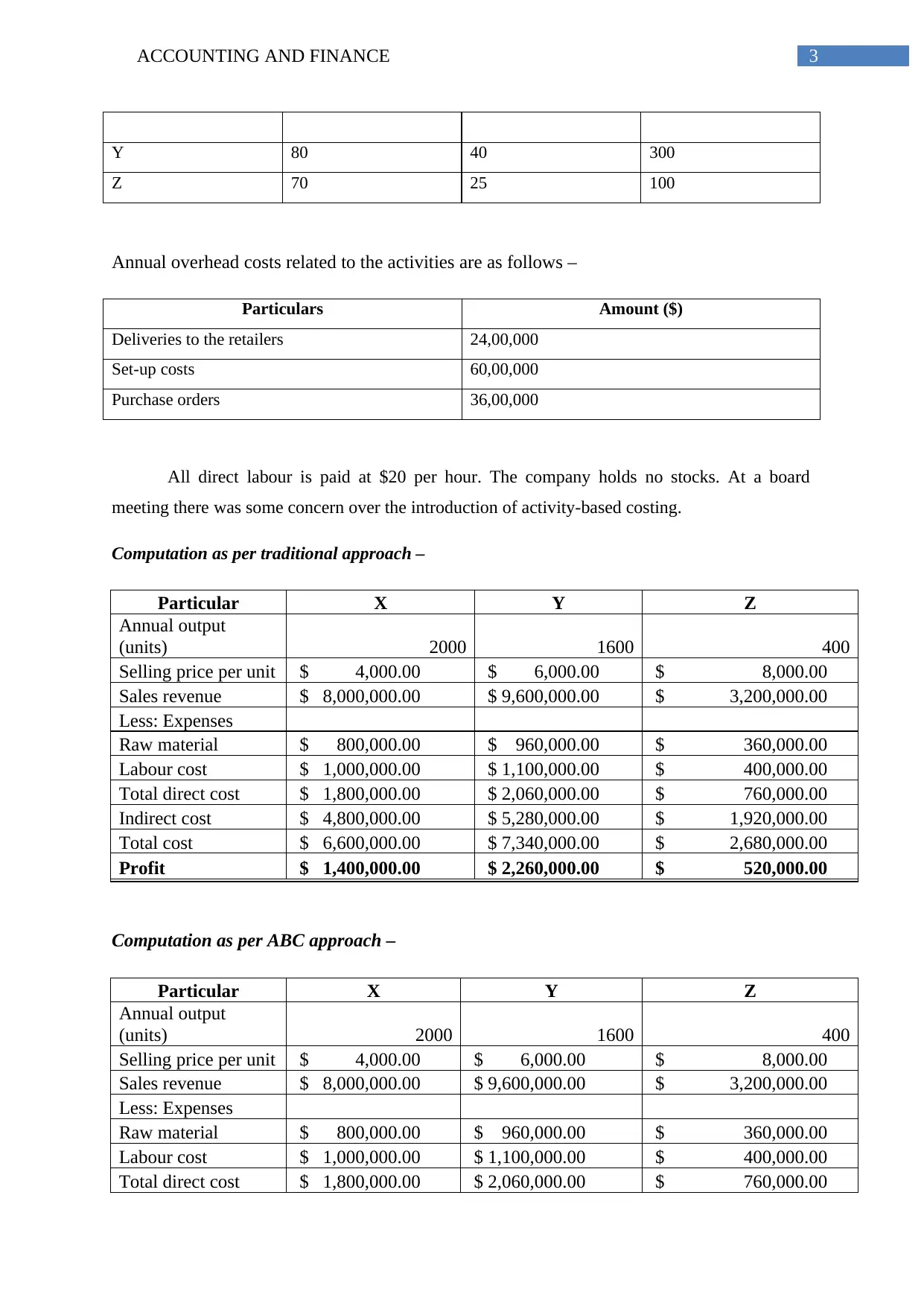
3ACCOUNTING AND FINANCE
Y 80 40 300
Z 70 25 100
Annual overhead costs related to the activities are as follows –
Particulars Amount ($)
Deliveries to the retailers 24,00,000
Set-up costs 60,00,000
Purchase orders 36,00,000
All direct labour is paid at $20 per hour. The company holds no stocks. At a board
meeting there was some concern over the introduction of activity-based costing.
Computation as per traditional approach –
Particular X Y Z
Annual output
(units) 2000 1600 400
Selling price per unit $ 4,000.00 $ 6,000.00 $ 8,000.00
Sales revenue $ 8,000,000.00 $ 9,600,000.00 $ 3,200,000.00
Less: Expenses
Raw material $ 800,000.00 $ 960,000.00 $ 360,000.00
Labour cost $ 1,000,000.00 $ 1,100,000.00 $ 400,000.00
Total direct cost $ 1,800,000.00 $ 2,060,000.00 $ 760,000.00
Indirect cost $ 4,800,000.00 $ 5,280,000.00 $ 1,920,000.00
Total cost $ 6,600,000.00 $ 7,340,000.00 $ 2,680,000.00
Profit $ 1,400,000.00 $ 2,260,000.00 $ 520,000.00
Computation as per ABC approach –
Particular X Y Z
Annual output
(units) 2000 1600 400
Selling price per unit $ 4,000.00 $ 6,000.00 $ 8,000.00
Sales revenue $ 8,000,000.00 $ 9,600,000.00 $ 3,200,000.00
Less: Expenses
Raw material $ 800,000.00 $ 960,000.00 $ 360,000.00
Labour cost $ 1,000,000.00 $ 1,100,000.00 $ 400,000.00
Total direct cost $ 1,800,000.00 $ 2,060,000.00 $ 760,000.00
Y 80 40 300
Z 70 25 100
Annual overhead costs related to the activities are as follows –
Particulars Amount ($)
Deliveries to the retailers 24,00,000
Set-up costs 60,00,000
Purchase orders 36,00,000
All direct labour is paid at $20 per hour. The company holds no stocks. At a board
meeting there was some concern over the introduction of activity-based costing.
Computation as per traditional approach –
Particular X Y Z
Annual output
(units) 2000 1600 400
Selling price per unit $ 4,000.00 $ 6,000.00 $ 8,000.00
Sales revenue $ 8,000,000.00 $ 9,600,000.00 $ 3,200,000.00
Less: Expenses
Raw material $ 800,000.00 $ 960,000.00 $ 360,000.00
Labour cost $ 1,000,000.00 $ 1,100,000.00 $ 400,000.00
Total direct cost $ 1,800,000.00 $ 2,060,000.00 $ 760,000.00
Indirect cost $ 4,800,000.00 $ 5,280,000.00 $ 1,920,000.00
Total cost $ 6,600,000.00 $ 7,340,000.00 $ 2,680,000.00
Profit $ 1,400,000.00 $ 2,260,000.00 $ 520,000.00
Computation as per ABC approach –
Particular X Y Z
Annual output
(units) 2000 1600 400
Selling price per unit $ 4,000.00 $ 6,000.00 $ 8,000.00
Sales revenue $ 8,000,000.00 $ 9,600,000.00 $ 3,200,000.00
Less: Expenses
Raw material $ 800,000.00 $ 960,000.00 $ 360,000.00
Labour cost $ 1,000,000.00 $ 1,100,000.00 $ 400,000.00
Total direct cost $ 1,800,000.00 $ 2,060,000.00 $ 760,000.00
Paraphrase This Document
Need a fresh take? Get an instant paraphrase of this document with our AI Paraphraser
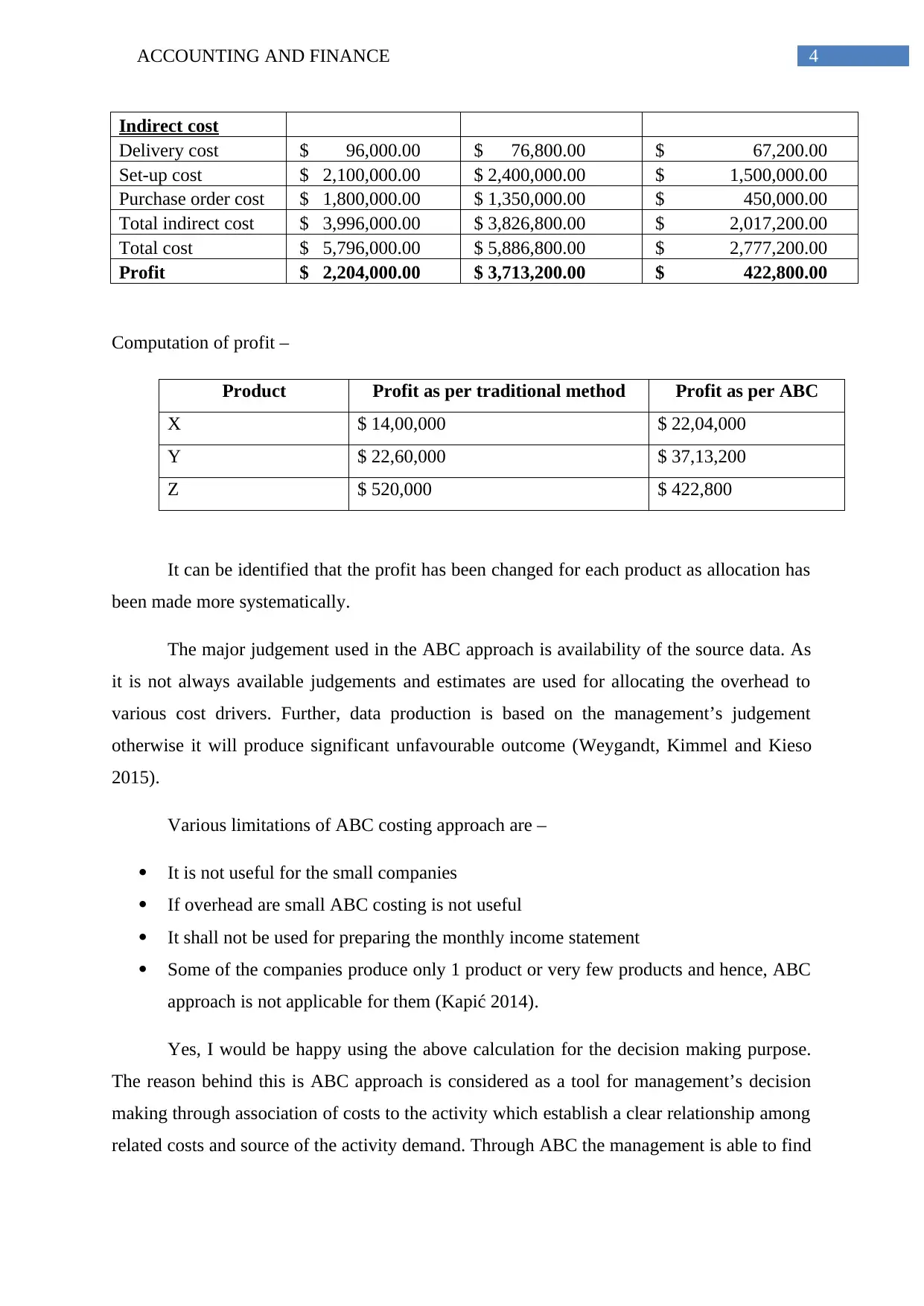
4ACCOUNTING AND FINANCE
Indirect cost
Delivery cost $ 96,000.00 $ 76,800.00 $ 67,200.00
Set-up cost $ 2,100,000.00 $ 2,400,000.00 $ 1,500,000.00
Purchase order cost $ 1,800,000.00 $ 1,350,000.00 $ 450,000.00
Total indirect cost $ 3,996,000.00 $ 3,826,800.00 $ 2,017,200.00
Total cost $ 5,796,000.00 $ 5,886,800.00 $ 2,777,200.00
Profit $ 2,204,000.00 $ 3,713,200.00 $ 422,800.00
Computation of profit –
Product Profit as per traditional method Profit as per ABC
X $ 14,00,000 $ 22,04,000
Y $ 22,60,000 $ 37,13,200
Z $ 520,000 $ 422,800
It can be identified that the profit has been changed for each product as allocation has
been made more systematically.
The major judgement used in the ABC approach is availability of the source data. As
it is not always available judgements and estimates are used for allocating the overhead to
various cost drivers. Further, data production is based on the management’s judgement
otherwise it will produce significant unfavourable outcome (Weygandt, Kimmel and Kieso
2015).
Various limitations of ABC costing approach are –
It is not useful for the small companies
If overhead are small ABC costing is not useful
It shall not be used for preparing the monthly income statement
Some of the companies produce only 1 product or very few products and hence, ABC
approach is not applicable for them (Kapić 2014).
Yes, I would be happy using the above calculation for the decision making purpose.
The reason behind this is ABC approach is considered as a tool for management’s decision
making through association of costs to the activity which establish a clear relationship among
related costs and source of the activity demand. Through ABC the management is able to find
Indirect cost
Delivery cost $ 96,000.00 $ 76,800.00 $ 67,200.00
Set-up cost $ 2,100,000.00 $ 2,400,000.00 $ 1,500,000.00
Purchase order cost $ 1,800,000.00 $ 1,350,000.00 $ 450,000.00
Total indirect cost $ 3,996,000.00 $ 3,826,800.00 $ 2,017,200.00
Total cost $ 5,796,000.00 $ 5,886,800.00 $ 2,777,200.00
Profit $ 2,204,000.00 $ 3,713,200.00 $ 422,800.00
Computation of profit –
Product Profit as per traditional method Profit as per ABC
X $ 14,00,000 $ 22,04,000
Y $ 22,60,000 $ 37,13,200
Z $ 520,000 $ 422,800
It can be identified that the profit has been changed for each product as allocation has
been made more systematically.
The major judgement used in the ABC approach is availability of the source data. As
it is not always available judgements and estimates are used for allocating the overhead to
various cost drivers. Further, data production is based on the management’s judgement
otherwise it will produce significant unfavourable outcome (Weygandt, Kimmel and Kieso
2015).
Various limitations of ABC costing approach are –
It is not useful for the small companies
If overhead are small ABC costing is not useful
It shall not be used for preparing the monthly income statement
Some of the companies produce only 1 product or very few products and hence, ABC
approach is not applicable for them (Kapić 2014).
Yes, I would be happy using the above calculation for the decision making purpose.
The reason behind this is ABC approach is considered as a tool for management’s decision
making through association of costs to the activity which establish a clear relationship among
related costs and source of the activity demand. Through ABC the management is able to find
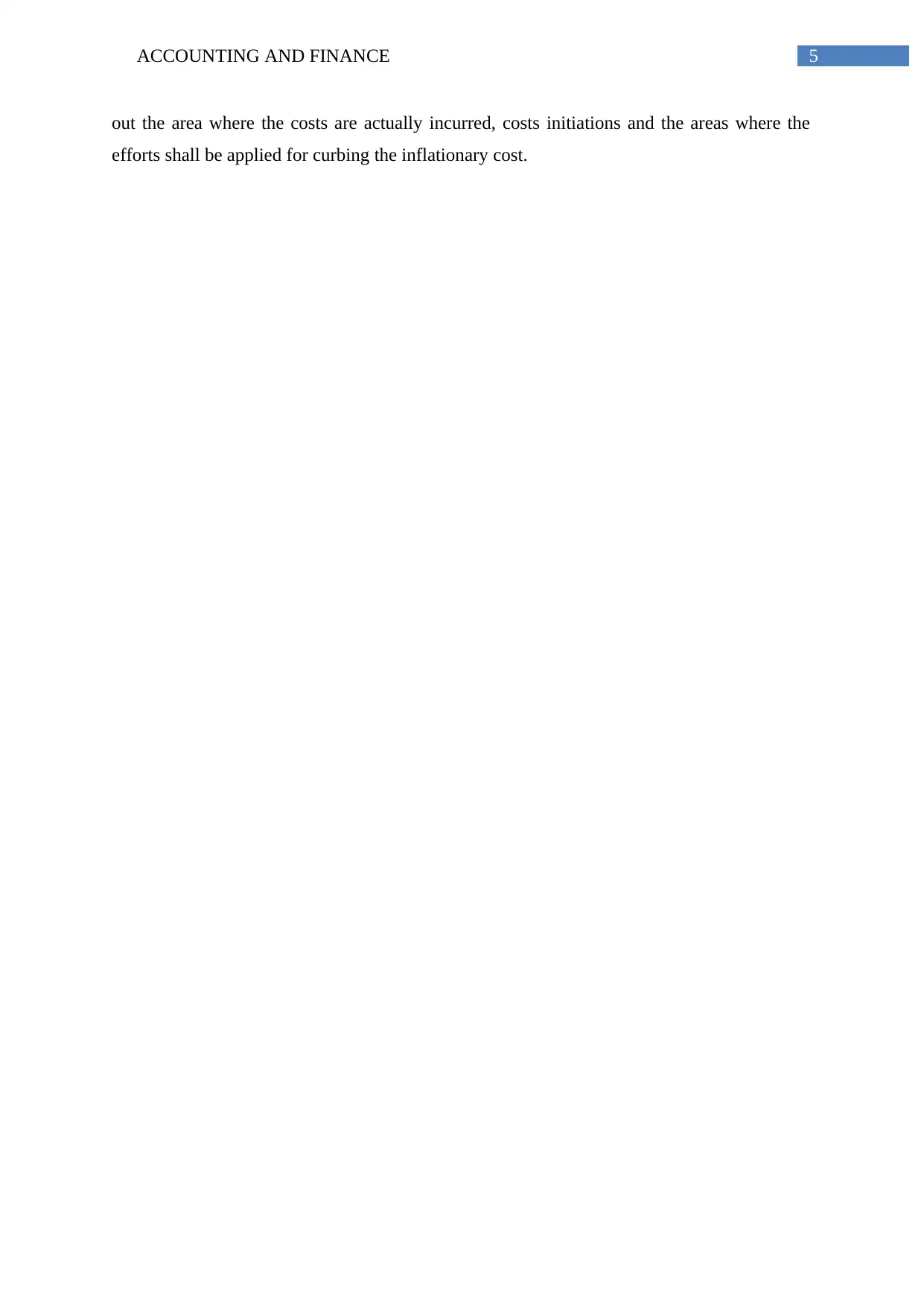
5ACCOUNTING AND FINANCE
out the area where the costs are actually incurred, costs initiations and the areas where the
efforts shall be applied for curbing the inflationary cost.
out the area where the costs are actually incurred, costs initiations and the areas where the
efforts shall be applied for curbing the inflationary cost.
⊘ This is a preview!⊘
Do you want full access?
Subscribe today to unlock all pages.

Trusted by 1+ million students worldwide
1 out of 6
Related Documents
Your All-in-One AI-Powered Toolkit for Academic Success.
+13062052269
info@desklib.com
Available 24*7 on WhatsApp / Email
![[object Object]](/_next/static/media/star-bottom.7253800d.svg)
Unlock your academic potential
Copyright © 2020–2025 A2Z Services. All Rights Reserved. Developed and managed by ZUCOL.




